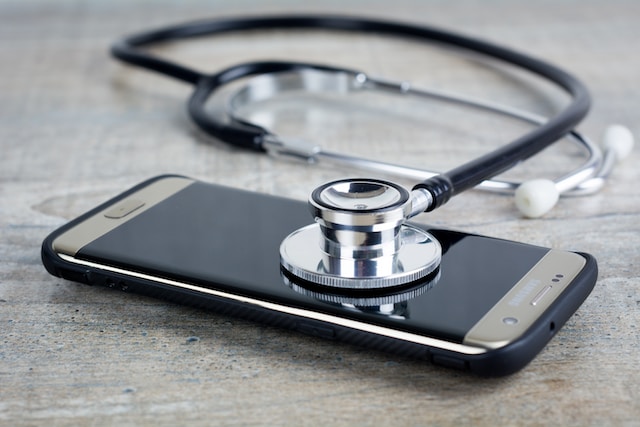Modern lifestyle trends are forcing patients and carers to rethink how mental health services can be delivered most effectively. With the COVID-19 pandemic causing (or exposing) a major step back in global mental health, this search has become more important than ever. It’s no wonder that mHealth is already a budding industry, valued at $111.5 billion in 2022, and forecast two grow eightfold over the next decade.
It can improve access to essential mental health services and empower professionals to offer personalized, data-driven advice. However, it’s not a magical cure-all, and its prescription must be carefully considered to avoid counter-intuitive effects associated with device use.

Understanding mHealth and mental health technology
mHealth, short for mobile health, refers to mobile devices such as smartphones and tablets to support health-related services and information. mHealth has revolutionized how individuals access, and professionals offer healthcare services by providing efficient and cost-effective solutions.
Examples include wearable tech, such as fitness trackers and smartwatches that monitor physical activity, heart rate, and sleep patterns. Or apps that offer mental health support, such as meditation and relaxation techniques, mood tracking, and cognitive-behavioral therapy (CBT).
Digital Therapeutics (DTx) is another emerging mHealth field. DTx involves prescription-based software interventions to treat medical conditions. These can be mobile apps, web-based programs, or virtual reality experiences. DTx provides the opportunity to offer hyper-personalized mHealth experiences for patients that need robust intervention.
Telepsychiatry and teletherapy, which enable remote communication between mental health professionals and patients, have become increasingly popular in the wake of the COVID-19 pandemic. This technology has made mental health services more accessible for those with transportation or mobility challenges.
Applications and advantages of mHealth for mental health
One key benefit of mHealth is the ability to monitor mental health conditions. Patients can use wearable devices and apps to track their symptoms, moods, and behavior patterns. This information can be shared with healthcare professionals, who can use it to make more informed decisions about treatment and care plans.
Another advantage of mHealth is the ability to provide peer support and psychoeducation. There are a variety of apps and online communities that allow people to connect with others going through similar experiences. These platforms offer a space for people to share their stories, find support, and learn coping strategies from others.
mHealth also has the potential to support evidence-based practices. For example, apps that provide CBT have been shown to be effective in treating depression and anxiety. These apps use goal-setting, behavioral activation, and cognitive restructuring techniques to help patients change negative thought patterns and behaviors.
While mHealth has the potential to improve the quality of mental health care by making it more personalized, accessible, and convenient, it shouldn’t replace traditional mental health services entirely. Rather, it should be used in conjunction with in-person care to provide more comprehensive treatments.
Remote access to psychological help

The COVID-19 pandemic had a devastating impact on mental health on a global scale. Anxiety and depression skyrocketed by 25% and brought to light the vulnerability of public mental health when isolated from professional interventions.
In that context, teletherapy and video consultations have emerged as popular alternatives. Teletherapy involves counseling, treatment, and/or support from a licensed mental health professional via video or voice call. Video consultations enable a psychiatrist to meet with a patient remotely to discuss symptoms, provide a diagnosis, and recommend treatment.
Text-based support services are also available, which can be especially helpful for those who prefer not to talk face-to-face or live in areas without reliable internet access. Text-based therapy can provide a convenient way for people to receive mental health support on their own schedule, allowing them to get help when needed.
IoT mHealth solutions
Major advancements in the world of consumer IoT (Internet of Things) are also driving change regarding the available mHealth solutions.
Popular devices like the latest Fitbit Charge, Apple Watch, or Samsung Galaxy Watch have built-in health tracking capabilities. These devices have sensors that track various health-related data, including heart rate, sleep patterns, physical activity, stress levels, VO2 Max, and more.
Integration with smart home technology, such as the Google Nest Hub or Amazon Echo, is another trend in IoT mHealth. These devices can collect data on a patient’s home environment, such as temperature, humidity, and air quality. They can also be used to set reminders for medication and appointments.
Data-driven personalized care is another benefit of IoT mHealth solutions for individuals and healthcare professionals. Devices like the Withings Body+ Scale or the Wyze Scale can collect and analyze weight, BMI, and body composition data.
With all these technologies becoming increasingly interconnected, it creates the opportunity to analyze how every aspect of an individual’s life, including behaviors, environment, and genetics, shapes their mental and physical health. This data can provide personalized nutrition and exercise recommendations, helping patients optimize their physical and mental health.

The negative impact of technology on mental health
As much as technology has revolutionized mental healthcare, it also poses some challenges. Research has linked excessive social media use to a higher prevalence of mental health issues, including depression, anxiety, and loneliness. Constant comparisons to others and peer pressure can also lead to low self-esteem.
Smartphone addiction and excessive screen time are also concerns. Overuse of smartphones has been linked to poor sleep quality, attention deficits, and impaired social interactions. Excessive screen time can lead to eye strain, headaches, and neck and back pain.
Individuals should be mindful of their technology use and consciously limit their screen time. Ironically, some new smartphones provide functions allowing users to track and manage their use. Self-governing strategies, such as exercise, social interactions, and technology fasts, are encouraged but more challenging in today’s fast-paced lifestyle.
Conclusion
Technology is revolutionizing the way healthcare providers and patients interact. The ubiquitous presence of technology puts data-driven and personalized health advice at everyone’s fingertips, literally.
However, well-documented issues related to technology addiction or excessive screen time may set back progress made in other areas.
Healthcare professionals carefully consider how they prescribe mHealth interventions, balancing them with conventional treatments. Patients should be educated to responsibly self-govern their use of mHealth technologies.











